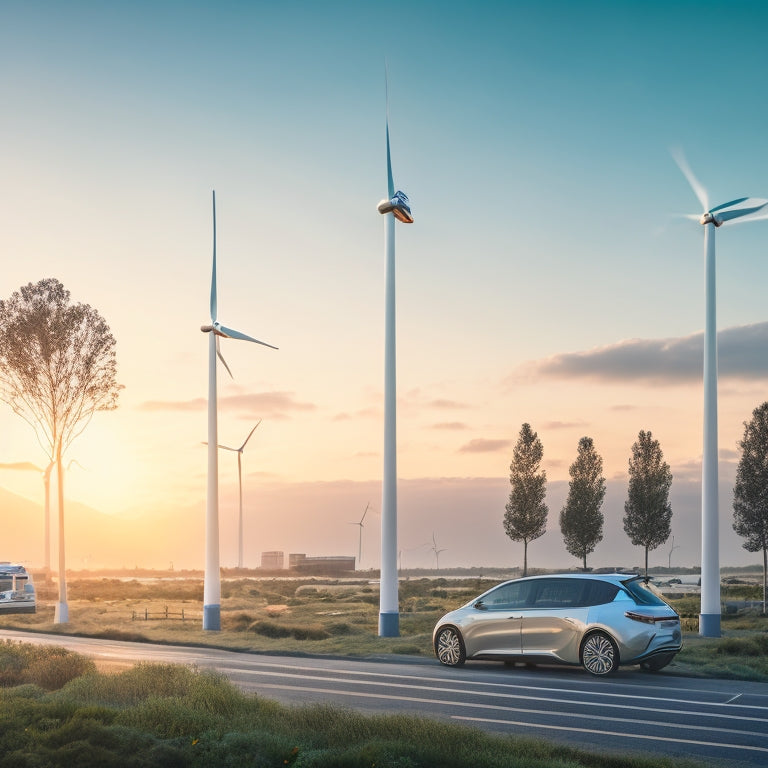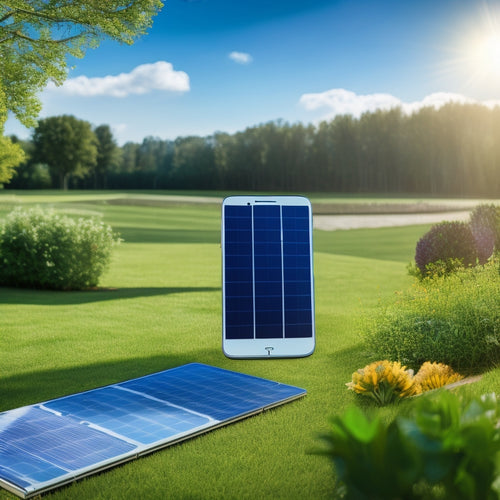
Charging Ahead: Green Energy for EV Infrastructure
Share
As you shift to electric vehicles, integrating renewable energy sources into EV infrastructure is essential to reduce dependence on fossil fuels and minimize carbon footprint. You'll want to incorporate solar power, wind farms, and hydrokinetic energy to create a sustainable energy supply. Next, you'll need to optimize energy storage for peak hours, ensuring grid resiliency and load management. Decentralized charging infrastructure and smart charging systems integration will also be vital. By designing carbon neutral EV ecosystems, you'll be creating a seamless, emission-free transportation experience. Now, let's take a closer look at the innovative strategies and technologies making it all possible.
Key Takeaways
• Integrate solar power into EV charging infrastructure to reduce dependence on fossil fuels and minimize carbon footprint.
• Implement energy storage solutions to address peak-hour energy demand and mitigate strain on the grid.
• Develop decentralized charging networks that incorporate local renewable energy sources and enable community engagement in urban planning.
• Optimize charging sessions with smart systems that adjust power output to match energy supply and minimize energy waste.
• Design carbon-neutral EV ecosystems that integrate green energy sources, energy storage, and emission-free transportation experiences.
Harnessing Renewable Energy Sources
As you shift to electric vehicles, incorporating renewable energy sources into your EV infrastructure becomes crucial, and harnessing solar power is an appealing option to reduce your dependence on fossil fuels.
However, you shouldn't overlook other renewable energy sources that can power your EV infrastructure. Wind farms, for instance, can provide a significant amount of clean energy to charge your vehicles.
Additionally, hydrokinetic energy, which harnesses the power of moving water, can also be a viable option. By diversifying your renewable energy portfolio, you can guarantee a reliable and sustainable supply of energy for your EV infrastructure.
Solar Power for EV Charging
By integrating solar panels into your EV charging infrastructure, you can harness the sun's energy to fuel your electric vehicles, reducing your reliance on the grid and minimizing your carbon footprint.
You can install solar roofs above your charging stations, generating clean energy to power your EVs. Alternatively, you can design parking canopies with built-in solar panels, providing shade for your vehicles while producing electricity.
This innovative approach not only reduces your environmental impact but also lowers your operating costs. With solar power, you'll be in control of your energy generation, ensuring a sustainable and reliable fuel source for your electric fleet.
Energy Storage for Peak Hours
When planning an EV infrastructure, you'll need to address how to mitigate peak-hour energy demand. That's where energy storage comes in - by implementing peak shaving strategies, you can reduce the strain on the grid during peak hours.
Now, let's explore grid-scale solutions that can help you optimize energy storage for a more efficient and sustainable EV ecosystem.
Peak Shaving Strategies
You can mitigate the strain on the grid during peak hours by employing peak shaving strategies, which involve utilizing energy storage systems to reduce the maximum power demand. By doing so, you can optimize energy distribution and reduce the likelihood of brownouts or blackouts. Peak shaving strategies can be implemented through various methods, including:
| Method | Description |
|---|---|
| Load Balancing | Shift non-essential loads to off-peak hours, reducing peak demand |
| Energy Arbitrage | Store energy during off-peak hours and release during peak hours |
| Time-of-Use (TOU) Optimization | Adjust energy usage based on time-of-day pricing |
| Demand Response Programs | Curtail energy usage during peak hours in response to incentives |
Grid Scale Solutions
Grid scale energy storage solutions, such as lithium-ion batteries and other advanced technologies, are being deployed to mitigate peak hour energy demand by storing excess energy generated during off-peak hours and releasing it when needed.
As you consider grid scale solutions, you'll want to prioritize Grid Expansion and Power Upgrades to guarantee seamless integration with existing infrastructure. By doing so, you'll be able to optimize energy distribution and reduce strain on the grid during peak hours.
With advanced energy storage systems, you can store excess energy generated during off-peak hours and release it when needed, reducing the likelihood of brownouts and blackouts.
Grid Resiliency and Load Management
Electric vehicle (EV) adoption is pushing the electrical distribution system to its limits, necessitating innovative load management strategies to guarantee grid resiliency.
As you oversee the electrification of transportation, you must prioritize Power Quality to ensure a stable and efficient energy supply.
Grid Congestion is a major concern, and it's essential to develop advanced load management systems that can detect and respond to changes in energy demand in real-time.
By implementing smart grid technologies, you can optimize energy distribution, reduce congestion, and maintain a reliable energy supply.
With the right strategies in place, you'll be able to balance energy demand and supply, ensuring a resilient grid that can support widespread EV adoption.
Decentralized Charging Infrastructure
By decentralizing charging infrastructure, utilities and charging station operators can create a more agile and responsive network that adapts to shifting EV demand patterns. You'll be able to dynamically allocate resources, reducing congestion and strain on the grid.
Decentralization enables community engagement, allowing local stakeholders to participate in urban planning and tailor charging infrastructure to their specific needs. This approach also facilitates the integration of local renewable energy sources, reducing reliance on the grid and increasing energy independence.
Smart Charging Systems Integration
You can optimize charging sessions with smart charging systems, which dynamically adjust power output to match available energy supply, reducing strain on the grid and ensuring a seamless charging experience.
By leveraging Vehicle Analytics, you can gather insights on driver behavior, vehicle performance, and energy consumption, allowing for precise demand forecasting and ideal charging schedules.
Smart charging systems can also enable Network Optimization, ensuring that energy distribution is efficient and reliable.
With real-time monitoring and adaptive control, you can minimize energy waste, reduce peak demand, and maximize the use of renewable energy sources.
Carbon Neutral EV Ecosystems
As the transportation sector continues to evolve, designing carbon neutral EV ecosystems is crucial for minimizing environmental impact and meeting stringent emissions regulations.
You're likely aware that EVs alone aren't enough; it's the entire ecosystem that matters. That's why you need to integrate green energy sources, energy storage, and smart grids to create a seamless, emission-free experience.
Governments are already offering EV incentives to encourage adoption, and cities are transforming into Green Cities, prioritizing sustainable infrastructure. By controlling the entire ecosystem, you can guarantee a carbon-neutral transportation system.
It's time to think holistically, combining innovative technologies and forward-thinking policies to create a sustainable future for transportation.
Frequently Asked Questions
Can EV Owners Sell Excess Energy Back to the Grid?
"As the master of your EV's energy fate, you're wondering: can you sell excess energy back to the grid? Yes, with Vehicle-to-Home technology and advanced Energy Storage systems, you can harness and resell your excess power, empowering you to take charge."
How Do Green Energy Sources Impact EV Charging Costs?
As you explore green energy sources, you'll find that renewable incentives and energy efficiency can greatly reduce your EV charging costs, allowing you to optimize your energy consumption and maximize your savings.
Are EV Charging Stations Compatible With All Vehicle Types?
When you're on the go, you wonder: are EV charging stations compatible with all vehicle types? Fortunately, most stations support various vehicle varieties, adhering to standardized charging standards like Level 2 and DC Fast Charging.
Can Decentralized Charging Infrastructure Reduce Energy Waste?
As you explore decentralized charging infrastructure, you'll find that Peer-to-Peer energy trading and Grid Resiliency enhancements can greatly reduce energy waste, allowing you to optimize your energy distribution and minimize losses.
Do Carbon-Neutral EV Ecosystems Require Government Incentives?
You'll find that carbon-neutral EV ecosystems indeed require government incentives to guarantee economic viability, as policy frameworks that promote private investment are essential for scaling sustainable infrastructure and reducing emissions.
Related Posts
-

What Tax Deductions Apply to Sustainable Building Materials?
You can claim various tax deductions for sustainable building materials, thanks to over 40 federal tax incentives sup...
-

What Cool Roof Tax Breaks Can Homeowners Claim?
You can claim federal tax credits of up to $500 and state and local incentives for installing cool roofs, which not o...
-

7 Best Solar Panel Upkeep Apps for Homeowners
You can optimize your solar panel's energy output and efficiency by up to 20% with regular maintenance, which is wher...


